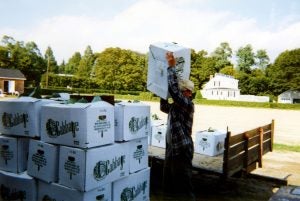On the family farm, there’s a clear distinction between wholesale and retail crews. Sure, there’s some necessary coordination of pickups and deliveries, but otherwise we’re pretty autonomous.
There is the occasional swing-person who straddles both worlds. On occasion, I get “drafted” as one of those cross-functional souls to help with the farmstand.
Not my wheelhouse, but it’s a welcome change of scenery. While I work behind the scenes and don’t interact with customers, one hears the exchanges. Most are cordial (if not mundane).
But Murphy’s Law is bound to prevail on rare occasions — and public relations is no exception! Anyone who works in retail knows that customers run the spectrum: from pleasant, to civil, to quirky, to downright entitled and belligerent. Luckily, the latter is unusual.
After a steady stream of customers, downtime is a welcome reprieve. It’s also time to reflect. As a “temp” employee, you’re bound to hear memorable stories from those working the register. From the eccentric who pay with $2 bills and Sacagawea dollar coins, to the person who strolls in with a paper bag (with eye cutouts) as a wannabe mask.
Some use their facetime as a hostile inquisition (“I heard so and so, why don’t you do this and that?”), but most just want truthful answers straight from the source. I applaud them. As farmers, we’re perfectly positioned to be a trustworthy, go-to information source.

After we opened the stand, we quickly realized that the standard slate of questions could be condensed into three common themes; so common they could’ve been written into an FAQ and posted on the premises. But like most farmers, we’d rather cultivate a face to face rapport with our clientele. We don’t shy from often difficult and critical conversations. As such, I generated some staff responses.
Here are some common Q&As:
Q: “Are you organic?”
A. We consider ourselves conventional and biointensive. We use the most eco-friendly, least disruptive methods possible to manage pests and diseases. This includes time-honored retro methods like crop rotation, as well as modern approaches, including pesticides.
Q. “Do you spray pesticides?”
A. We use pesticides when necessary — all of which have been thoroughly tested for environmental and human safety. Organic systems use pesticides too, and “natural” doesn’t imply safety. Here’s a list (refers them to USDA’s Organic Materials Review Institute website with a listing of approved organic materials).
Q. “Do you use GMOs?”
A. We like to use the term biotechnology. It’s less sensational and more honest. It’s a safe breeding tool with an impeccable 25-year track record. We don’t grow any biotech varieties (because there aren’t any leafy greens, root crops, or herbs available), but the sweet corn from local farmers probably is. This allows farmers to grow corn with virtually no pesticides!
But there was one question the staff wasn’t equipped for this summer — one we’ve never fielded in 20 years. It wasn’t even face to face, but a frenzied phone call about our home-baked cookies.
My cousin is a baking whiz, and runs her own cookie enterprise. The recipes happen to call for potato flour. What’s so controversial about that? Well, if heated to sufficient temperatures, it turns run of the mill potato starch into polyacrylamide, a known carcinogen.
Spuds a cancer risk? Say it ain’t so. There was a huge media blow-up in the early 2000s over this very issue (actually any kind of potato based product, especially chips). Moms railed against it, and politicos ranted.

Indeed, like most controversies, after the facts were unveiled, the risks were decidedly overblown — and it fell into obscurity. Despite the uproar, most were unwilling to give up their munchables.
Presumably, though, social media reignited this customer’s pilot light. They were very exasperated, almost to the point of hyperventilating. What a tortured realization. Were we dosing our customers with poison? What were we doing to contain the risk?
Like your potatoes sufficiently browned? Excessive heat (>340 degrees F) is the major cause of formation. A specific amino acid (asparagine) and sugars react together to form it. Not some sorcery presided over by a cackling witch at a cauldron, but a very routine — and well-documented — reaction. How do we manage it? We’ve always baked at a much lower temperature anyway.
Some other steps?
- Avoid storing potatoes in the fridge. This causes sugar formation. Instead, store in a dark, cool place.
- Blanching (soaking in water for 15-30 minutes and then blotting) pre-cooking will remove many of the precursors necessary for polyacrylamide formation.
- Cooking method also influences formation. For example, frying forms more polyacrylamide than roasting or baking, in that order.
- Cook to a golden yellow rather than brown color (lower temperatures at a reduced time).
- Variety selection. New potato varieties don’t turn golden brown when they’re fried. Instead, they take on a more whitish color.
- There’s also the Simplot potato, a biotech variety that restricts asparagine production at the molecular level.
Technology and best practices for the win! With all this said, are we going a bit overboard? Granted, the above steps don’t hurt anyone, and everyone is free to gauge their individual risk tolerance.
An interesting tidbit that puts our risk obsession/aversion (no matter how inconsequential) in perspective is acrylamide’s (polyacrylamide’s building block) inclusion on California’s Proposition 65 list.
You know, that infamous label that blindly calls anything and everything carcinogenic or teratogenic (causes birth defects) without any context about 1) how much is actually present, or 2) what it would take to make someone sick. It’s just a declaration of presence, even if it’s a measly molecule’s worth.
The best analogy I’ve seen is that it’s a piercing “alarm that rings equally loudly about smaller amounts of low-risk substances, and huge amounts of potentially harmful chemicals.”
And the concern is based off animal studies, where they’re fed an inordinate amount of what would never be anticipated (short or long term) or reasonable in a human diet.
That’s the major point about chemophobic scares, be they pesticides or humble spuds. Ignorance (often no fault of the individual) is calibrated to hysteria. That’s a smoldering fire we need to quench with facts.
Tim Durham’s family operates Deer Run Farm — a truck (vegetable) farm on Long Island, New York. As an agvocate, he counters heated rhetoric with sensible facts. Tim has a degree in plant medicine and is an Associate Professor at Ferrum College in Virginia.



